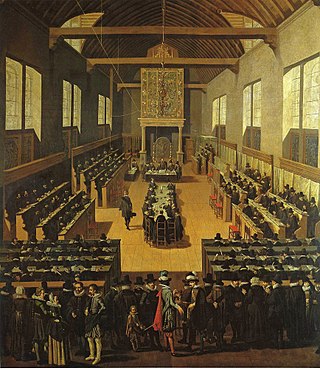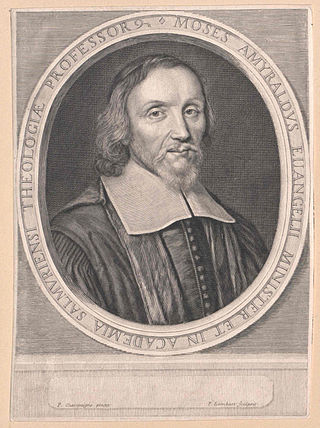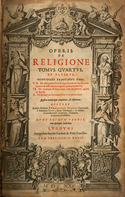
Arminianism is a movement of Protestantism initiated in the early 17th century, based on the theological ideas of the Dutch Reformed theologian Jacobus Arminius and his historic supporters known as Remonstrants. Dutch Arminianism was originally articulated in the Remonstrance (1610), a theological statement submitted to the States General of the Netherlands. This expressed an attempt to moderate the doctrines of Calvinism related to its interpretation of predestination.

Reformed Christianity, also called Calvinism, is a major branch of Protestantism that began during the 16th-century Protestant Reformation. In the modern day, it is largely represented by the Continental Reformed, Presbyterian, and Congregational traditions, as well as parts of the Anglican and Baptist traditions.

Perseverance of the saints, also known as preservation of the saints, is a Calvinist doctrine asserting that the elect will persevere in faith and ultimately achieve salvation. This concept was initially developed by Augustine of Hippo in the early 5th century, based on the idea of predestination by predeterminism. In the 16th century, John Calvin and other reformers integrated this idea into their theological framework. The doctrine of perseverance of the saints is rooted in this understanding of predestination and continues to be a central tenet of Reformed theology today.

The Synod of Dort was a European transnational Synod held in Dordrecht in 1618–1619, by the Dutch Reformed Church, to settle a divisive controversy caused by the rise of Arminianism. The first meeting was on 13 November 1618 and the final meeting, the 154th, was on 9 May 1619. Voting representatives from eight foreign Reformed churches were also invited. Dort was a contemporary Dutch term for the town of Dordrecht.
Orthodoxy is adherence to correct or accepted creeds, especially in religion. Orthodoxy within Christianity refers to acceptance of the doctrines defined by various creeds and ecumenical councils in antiquity, but different Churches accept different creeds and councils. Such differences of opinion have developed for numerous reasons, including language and cultural barriers. Eastern Orthodoxy and Oriental Orthodoxy are sometimes referred to simply as "Orthodoxy". In some English-speaking countries, Jews who adhere to all the traditions and commandments as legislated in the Torah are often called Orthodox Jews. Sunni Islam is sometimes referred to as "Orthodox Islam".

Jacobus Arminius was a Dutch Reformed minister and theologian during the Protestant Reformation period whose views became the basis of Arminianism and the Dutch Remonstrant movement. He served from 1603 as professor in theology at the University of Leiden and wrote many books and treatises on theology.

Unconditional election is a Calvinist doctrine relating to predestination that describes the actions and motives of God prior to his creation of the world, when he predestined some people to receive salvation, the elect, and the rest he left to continue in their sins and receive the just punishment, eternal damnation, for their transgressions of God's law as outlined in the Old and New Testaments of the Bible. God made these choices according to his own purposes apart from any conditions or qualities related to those persons.

Francis Turretin was a Genevan-Italian Reformed scholastic theologian.

Gisbertus Voetius was a Dutch Calvinist theologian.

Johannes Cocceius was a Dutch theologian born in Bremen.
The Five Points of Calvinism constitute a summary of soteriology in Reformed Christianity. Named after John Calvin, they largely reflect the teaching of the Canons of Dort. The five points assert that God saves every person upon whom he has mercy, and that his efforts are not frustrated by the unrighteousness or inability of humans. They are occasionally known by the acrostic TULIP: total depravity, unconditional election, limited atonement, irresistible grace, and perseverance of the saints.

Amyraldism is a Calvinist doctrine. It is also known as the School of Saumur, post redemptionism, moderate Calvinism, or hypothetical universalism. It is one of several hypothetical universalist systems.

The Princeton theology was a tradition of conservative Reformed and Presbyterian theology at Princeton Theological Seminary lasting from the founding of that institution in 1812 until the 1920s, after which, due to the increasing influence of theological liberalism at the school, the last Princeton theologians left to found Westminster Theological Seminary. The appellation has special reference to certain theologians, from Archibald Alexander to B. B. Warfield, and their particular blend of teaching, which together with its Old School Presbyterian Calvinist orthodoxy sought to express a warm evangelicalism and a high standard of scholarship. W. Andrew Hoffecker argues that they strove to "maintain a balance between the intellectual and affective elements in the Christian faith."

Johannes Maccovius, also known as Jan Makowski, was a Polish Reformed theologian.

The history of the Calvinist–Arminian debate begins in the early 17th century in the Netherlands with a Christian theological dispute between the followers of John Calvin and Jacobus Arminius and continues today among some Protestants, particularly evangelicals. The debate centers around soteriology and includes disputes about total depravity, predestination, and atonement. While the debate was given its Calvinist–Arminian form in the 17th century, issues central to the debate have been discussed in Christianity in some form since Augustine of Hippo's disputes with the Pelagians in the 5th century.
Lutheran orthodoxy was an era in the history of Lutheranism, which began in 1580 from the writing of the Book of Concord and ended at the Age of Enlightenment. Lutheran orthodoxy was paralleled by similar eras in Calvinism and tridentine Roman Catholicism after the Counter-Reformation.

Second scholasticism, also called Modern scholasticism, is the period of revival of scholastic system of philosophy and theology, in the 16th and 17th centuries. The scientific culture of second scholasticism surpassed its medieval source (Scholasticism) in the number of its proponents, the breadth of its scope, the analytical complexity, sense of historical and literary criticism, and the volume of editorial production, most of which remains hitherto little explored.

Richard A. Muller is an American historical theologian.

Petrusvan Mastricht was a Reformed theologian.
Protestant scholasticism or Protestant orthodoxy was academic theology practiced by Protestant theologians using the scholastic method during the era of Calvinist and Lutheran orthodoxy from the 16th to 18th centuries. Protestant scholasticism developed out of the need to clearly define and defend church doctrine against the Catholic Church and other Protestant churches. It refers to both Lutheran scholasticism and Reformed scholasticism. Anglicanism never developed a scholastic theology; however, Anglican writers in the 1600s studied early Christian writings to prove that Anglicanism had faithfully followed the teachings and practices of the early Church.


















